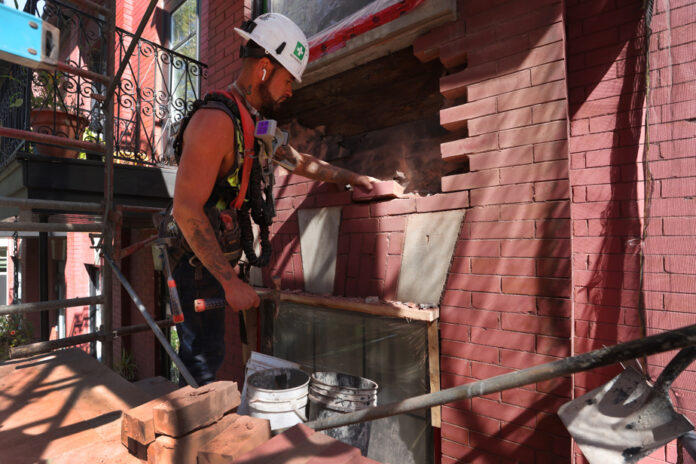To encourage the reuse of bricks on Montreal construction sites, a new platform makes it possible to match donors and buyers. Launched on Monday, Web-Recyc tackles two major obstacles in the establishment of a circular economy under construction: the mesh between supply and demand and the cost of labor.
Are you soon to start a renovation project that involves dismantling a brick wall? Brique Recyc and Architecture Sans Frontières Québec (ASFQ) want your bricks, especially if they are “La Prairie red”, “mixed corrugated” or “old maple bark”. Highly sought after for the restoration of buildings, these often century-old bricks, made here at a time when Quebec was still making them, still have good years of life ahead of them. However, they most often end up in the dump.
“We do 3,000 estimates a year. Often, we cannot repair the building because we do not have that brick. You have to throw everything away and start over,” laments Tommy Bouillon, president of Brique Recyc and Maçonnerie Gratton.
However, “we have this brick: in the landfill container,” continues Bruno Demers, general manager of ASFQ, the humanitarian arm of the Ordre des architectes du Québec.
It is therefore to encourage building owners to pass their bricks on to the next one and to allow buyers to find quality bricks at a good price that this networking platform was launched.
Web-Recyc offers donors a turnkey service by delivering small stackable boxes to the site in which the bricks will be placed. These boxes are placed directly on the scaffolding, which avoids throwing and damaging the product.
The contractor must respect a protocol during dismantling, but his task is in no way complicated, assures Tommy Bouillon. Once the boxes are filled, they are transported to Brique Recyc, then the bricks are evaluated, sorted and cleaned with the machine invented by Tommy Bouillon and his associates. This portable machine, which they have been using on Maçonnerie Gratton construction sites since 2021 and which will soon be distributed in the United States, can rehabilitate worn bricks and detach residual mortar using a diamond saw, guided by a laser system. This way of doing things saves time and requires less manpower.
In its search for donations, Web-Recyc mainly targets owners of buildings of four stories or less, which constitute the majority of Montreal’s housing stock. Since this business model is only possible if there are no storage costs, donors are invited to submit their offer from the start of their renovation project, even before the permits have been obtained.
For each qualifying minimum donation of $500, the donor will receive a tax receipt issued by ASFQ. A $500 donation is roughly equivalent to the bricks of a standard facade of a small Montreal duplex. A receipt for charitable donations is currently the only tax incentive in place to promote the reuse of materials, points out Bruno Demers. ASFQ, which will inaugurate in the coming months the new premises, five times larger, of its Éco-Réno store, which already issues such receipts as part of its Materials Without Borders program.
According to Tommy Bouillon, the financial incentive goes beyond the tax receipt. “Our cribs are so small they can be stacked on the owner’s lot. You eliminate a cost of occupying the public domain, you disturb the neighborhood less. » Container rental costs are also avoided.
As for the warranty for used bricks, he specifies that it is up to the company that installs them to establish it. The bricks will be chosen and sorted according to three quality grades. “It’s not the brick that’s expensive when there’s a problem,” he points out. The last 100 years have been a good test for bricks. At the time, they made bricks of incredible quality for our Quebec climate, with cures of drying in the open air which made them almost eternal bricks […] If there is a good judgment of the installer company, for the guarantee, there is no risk. It’s always been done. »
Could Web-Recyc expand elsewhere in Quebec? “It is in the intentions, answers Bruno Demers. There are discussions underway to go to Quebec. »
CRD waste (construction, renovation, demolition) represents 41% of residual materials generated in Quebec. Their reduction is one of the issues on which Recyc-Québec has been working for a long time, recalled its new president and general manager, Emmanuelle Géhin, during the launch of Web-Recyc. A committee of experts, coordinated by the Crown corporation, submitted its recommendations to the Minister of the Environment earlier this year. “We are trying to see how we could go even further,” said Ms. Géhin. We will possibly renew the work of this committee to be able to have a concrete roadmap that goes beyond the regulatory proposal that had been previously identified. »
“We must redouble our efforts to reduce the rate at which we bury our materials,” added Marie-Andrée Mauger, Mayor of Verdun and responsible for the ecological transition and the environment on the Executive Committee of the City of Montreal. The 16,000 permits issued each year by Montreal boroughs, 97% of which concern renovation projects, are all opportunities to promote the circularity of materials, she believes. The City of Montreal also intends to do its part. “We want to work on our own circularity index to ensure that we put forward criteria to valorize materials in the context of projects to repair our built heritage. »








